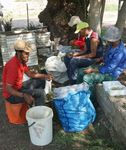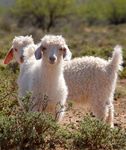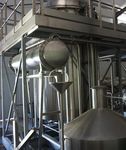South Africa Transformation towards sustainable land use - OroVerde
←
→
Page content transcription
If your browser does not render page correctly, please read the page content below
Case study
South Africa
Transformation towards sustainable land use
The work in the Baviaanskloof is seeking to rehabilitate degraded areas and provide local farmers with
new sources of income. A local NGO (Living Lands), a South African social enterprise (Grounded) and a
Dutch-based private investor (Commonland) are supporting the organic cultivation and processing of
rosemary and lavandin.
Initial situation and landscape in South Africa since 2015. In addition, the Baviaanskloof is
very isolated. This complicates the supply of food and other
goods, but also the selling of products from the Baviaansk-
The Baviaanskloof is a valley located in the Eastern Cape Pro- loof.
vince of South Africa that runs between the Baviaanskloof
Mountains to the north and Kouga Mountain range to the
south. The Baviaanskloof Hartland, the privately owned wes-
tern part of the Baviaanskloof, has an area of approximately
41,000 ha. The Baviaanskloof belongs to the water catch-
ment area of the city of Port Elizabeth. Therefore, the lands-
cape not only provides local farmers with a source of income
Overview
but also plays a crucial role in meeting the growing water
Country: South Africa
demands of the area and the city of Port Elizabeth with more
than 1 million downstream users. Implementing partner: Living Lands (rehabilitation)
The Baviaanskloof Hartland is home to a community of Target group: 24 farms and 2,300 inhabitants
2,300 people. The land belongs to 24 private landowners Baviaanskloof Hartland: 41,000 ha
with farms between 180 and 8,000 ha of land. Ten of the
landowners grow crops (vegetables, legumes), keep animals, Lavendin and rosemary: 55 ha
mostly Angora goats, and provide accommodation for tou-
Partner: Grounded (management of local processing plant,
rists to earn an income. One farm is run by community mem-
DevCo)
bers. The other landowners no longer live in the area.
Duration: Rehabilitation since 2009; Commonland: 2016–2036
Among other things, the channelling of water and overgra-
zing by livestock, have led to soil degradation as well as soil Funding sources: Founding of DevCo: EUR 1.47 million loan
erosion and reduced water retention in the valley and on from Commonland; donors for rehabilitation: Department of
mountain slopes. These problems have led to farmers ear- Environmental Affairs South Africa (DEA), Dutch Government,
ning less income from farming and animal husbandry. The UNDP, The CocaCola Africa Foundation, Netherland Postcode
situation is aggravated by the drought that has persisted LotterijCase study: Transformation towards sustainable land use
Main stakeholders and their challenges in by different sources, such as the South African and Dutch
Governments and other donors. In the Baviaanskloof, Com-
the landscape monland provides financial and in kind support to the Dev-
Co, Living Lands and Grounded teams. Commonland imple-
ments large scale restoration projects worldwide based on
Due to the remoteness and the dry climate, all stakeholders the so called four Returns framework. This framework seeks
in the Baviaanskloof are struggling to meet challenges. The to achieve four returns (inspirational, social, natural and sus-
most important stakeholders are the farmers, who have re- tainable financial returns) over a period of 20 years. In addi-
cognized that the existing agricultural land use destroys the tion, the concept tries to connect three landscape zones (na-
once fertile soil. Therefore, a transformation to other land tural, combined and economic). Commonland contributes to
uses and income sources is required. Besides the farmers, a the Bonn Challenge, a global effort to restore 150 million ha.
key stakeholder is the South African NGO Living Lands. Living of degraded land.
Lands has been supporting the local community with reha-
bilitation measures on the degraded mountain slopes for ten
years. With financial support from the Dutch Commonland
foundation, The Baviaanskloof Development Company (Dev-
Co) was founded. The DevCo granted a loan to four farmers,
enabling them to sell parts of their grazing livestock to earn
an income from sustainable agriculture. Today, the four far-
mers grow a total of 55 ha. of lavandin and rosemary. The
specially founded DevCo processes these herbs into essential
oils. The four farmers who received a loan from DevCo are
the main shareholders of the company. Commonland and
the social enterprise Grounded have a minor stake. Groun-
ded and Living Lands assisted the farmers in developing the
business case. Today, Grounded still supports the farmers
with the management of DevCo.
The different measures within the landscape are funded
Figure 1: Key stakeholder of this study.
©OroVerde - Tropical Forest Foundation Global Nature Fund 2Case study: Transformation towards sustainable land use
back into the soil. To date, over 40,000 such holes have been
Forest Landscape Restoration constructed.
So far there is no generally accepted definition for Forest Regenerative agriculture and animal husbandry
Landscape Restoration, although there are various glo-
bal initiatives, such as the Bonn Challenge, which aims Regenerative agriculture is a completely new concept for
to restore 150 million hectares of degraded land by 2020. DevCo farmers. The aim of the concept is to use the agricul-
In our work, however, the following characteristics of FLR tural land economically while improving and maintaining
projects have proven to be relevant: soil quality and biological diversity. The measures in the Ba-
viaanskloof valley on the farmers‘ land have been adapted
Contribution to the conservation and regeneration
to the soil conditions and needs of the respective farmers.
of natural ecosystems.
Currently, only the four farmers of the Baviaanskloof Deve-
lopment Company (DevCo) are implementing regenerative
Restoration of ecological, social and economic
agriculture practices. In cooperation with the DevCo General
functions for humans and nature.
Manager, each farmer develops a management plan for his
farm. This plan includes catch crops and fodder crops bet-
Stakeholder involvement and participatory plan-
ween the main crops for the diversification of the fields. In
ning and decision-making processes.
addition, all farmers have their own nurseries and produce
compost that is enriched with nutrients and biochar to be
Adaptation of measures to the local context.
used as a biological fertilizer. The cultivation of fodder crops
ensures the feeding of the goats and enables the farmers
Focus on a whole landscape with different forms
to keep areas on the slopes for rehabilitation free from live-
of land use.
stock. In addition, DevCo farmers have reduced the number
of goats, thus reducing the risk of overgrazing. An agreement
between the farmers and Commonland stipulates that the
number of animals will be reduced by one goat each if more
than 30,000 Rand (approx. EUR 1,950) per hectare is earned
from the cultivation of lavendin and rosemary.
Implementation and measures on lands-
cape level
Restoring the ecosystem with Spekboom trees and water
ponds
A total area of 10,000 ha. is degraded in the Baviaanskloof
Hartland. Living Lands has been working on the rehabilitati-
on of the Baviaanskloof and especially on the mountain slo-
pes for over ten years. Living Lands is using various measu-
res to increase the carbon content of the soil, improve water
retention and reduce soil erosion. More than 1,000 ha. have
already been rehabilitated and a contribution made to global
Forest Landscape Restoration Initiatives (see info-box).
A central measure is the planting of native Spekboom trees
(Portulacaria afra), which is currently taking place on 2,500
ha. Small branches of the thorn bush are placed around the
small trunk of the Spekboom stems to protect them from
wild animals and to stimulate them to spread and take new
roots. In addition, rows of Spekboom are planted at relevant
locations, which act as natural dams to slow down the flow
of water on the mountain slopes and reduce erosion. The
Coca Cola Africa Foundation, Global Environment Facility and
the Dutch Postcode Lottery are funding the tree planting.
Another measure to rehabilitate the soil is the digging of se-
micircular bunds (ponding). Living Lands hires people from
the local community to dig the holes and insert loose bran-
ches of the thorn bush. This measure also slows down rain- Semicircular water retention holes to reduce water runoff. These
water runoff and the composting branches bring nutrients are dug by hand.
©OroVerde - Tropical Forest Foundation Global Nature Fund 3Case study: Transformation towards sustainable land use
Essential oils as a new source of income in the Baviaanskloof
The goal of the Baviaanskloof Development Company (Dev-
Co) is to create an alternative source of income for the far-
mers alongside animal husbandry and tourism. The DevCo
supports the farmers in introducing organic farming practi-
ces and produces essential oils and dried herbs from a va-
riety of herbs, including Lavandin abrialis, different kinds of
rosemary, and indigenous plants. Farmers collaborated with
Living Lands and the social enterprise Grounded to develop
the business idea. Today four farmers are shareholders of the
Baviaanskloof Development Company besides Commonland
and Grounded, which hold minor stakes. Commonland provi-
ded a total loan of EUR 1.47 million to support the establish-
ment of DevCo. This money has been used to build a distillery,
provide loans to the four DevCo farmers and to buy working
capital. The loans to the farmers enabled them to switch to
regenerative agriculture and start growing the herbs. The
advantages of rosemary and lavendin are that they require
very little water and need a smaller area than goats for the
same yield. In addition, animals do not eat the plants and
goats can graze in the fields. This means that land can be
made available for rehabilitation measures. At the begin-
ning, the DevCo started with 100 ha. of rosemary and lava-
ndin. For various reasons, this volume initially turned out to
be too large. Today, the four farmers cultivate rosemary and
Rosemary cultivation is one of the building blocks of sustainable
lavandin on 55 ha. under regenerative agriculture. The herbs land management.
are either dried or processed into essential oils and sold on
the domestic market. In addition, DevCo is obtaining orga-
nic certification. Currently, Grounded supports DevCo as its
The Angora goats do not eat the herbs and can therefore graze on Essential oils are extracted from rosemary and lavandin in the
the cultivated area. distillation facility.
©OroVerde - Tropical Forest Foundation Global Nature Fund 4Case study: Transformation towards sustainable land use
Managing Director and is responsible for additional funding,
business partners and marketing the products. In the long
term, it is planned that the farmers will continue to run the
company independently.
Challenges and solutions for Forest and
Landscape Restoration (FLR) Projects
On a landscape level
Building local capacities is a major challenge in many FLR
projects. In the Baviaanskloof, a decisive advantage is that
the local NGO, Living Lands, has committed itself to the land-
scape in the long term and that its employees are part of
the local community. They are available as important contact
persons, are immediately aware of problems and support
the community and farmers. Commonland‘s investment has
also enabled the involvement of other experts, for example,
for the management and marketing of DevCo (Grounded), as
well as for the conversion to regenerative agriculture. How-
ever, the support of local capacities reaches its limits when
it comes to the social structures and unequal distribution of Community members are hired for digging water retention ponds.
land ownership in the Baviaanskloof. As a result of apartheid,
the land, with the exception of the community farm, belongs ving Lands.
to white landowners. Coloured people in the Baviaanskloof Another challenge for FLR projects are the risks for the local
can therefore currently only indirectly participate in the eco- population, which implements measures. In the Baviaansk-
nomic development through work for the farmer or for Li- loof, these risks arise from the shift from livestock to rose-
mary and lavender. Here, Commonland‘s investment and
Nursery for the seedlings of the Spekboom tree. long-term commitment reduce the farmers‘ risks. The lower
interest rates compared to market conditions and the grea-
ter flexibility in repayment reduce the risk for farmers going
bankrupt. This advantage has already mitigated the income
from essential oils that was lower than expected in the first
years.
The fact that the farmers themselves developed the busi-
ness idea for DevCo has a positive effect on the sustainability
of the measures. The involvement of the farmers promotes
self-responsibility and ownership. This increases the farmers‘
motivation to implement the new forms of land use in the
future. The long-term success of the measures in the Bavi-
aanskloof, however, depends decisively on the further deve-
lopment of DevCo. As soon as the cultivation and sale of ro-
semary and lavender generates profits, the incentive for the
farmers to continue with regenerative agriculture and not
to increase the herd of goats again increases. Living Lands‘
work in the Baviaanskloof focuses on the entire landscape
and tries to unite the different needs and forms of land use.
This is another crucial factor for the long-term transformati-
on of a landscape and should be part of any project to restore
forests and landscapes.
©OroVerde - Tropical Forest Foundation Global Nature Fund 5Case study: Transformation towards sustainable land use
Commonland‘s four-Returns Framework is designed for lar-
On an international level ge landscapes and is therefore basically scalable. However,
experience with the Baviaanskloof has shown that new
Activities such as rehabilitation in the Baviaanskloof can measures should first be tested on a small area before being
contribute to the achievement of global goals such as the implemented on a large scale. It is therefore advisable to
Bonn Challenge, which aims to restore 150 million ha. of de- start with pilot actions or to involve a local partner who has
graded land by 2020. Investments by private donors are an already gained experience with similar measures before im-
important key to financing the restoration of degraded land. plementing a large-scale project.
In contrast to the usual private investors, however, Com-
monland has no short-term return expectations, but gives
a commitment for a period of 20 years, which reduces the
risk for local stakeholders. In addition, Commonland grants
the implementation partners a high degree of flexibility in
the measures. The decisive factor for taking measures are
the concrete needs on the ground. Commonland‘s high level
of trust in its local partners and the central role that Living
Lands plays in the Baviaanskloof, allowing them to act accor-
ding to the needs of the local stakeholders.
With regard to the transferability of the activities in the Ba-
viaanskloof, it should be noted that the individual measures
result from different projects and were adapted to the needs
of the landscape and its inhabitants. This makes it difficult
to transfer the activities to other regions. However, the land-
scape approach of the local NGO can be assessed as positive
and recommended for other landscapes. Furthermore, the
Commonland‘s four-Returns Framework can also be applied
in other areas. This is because it embeds the landscape ap-
proach via the three zones and takes into account the needs
of local people and nature via the four returns.
The workers prepare the rosemary cuttings for cultivation. Planting the native Speckboom tree on the mountain slopes im-
proves soil quality and protects against erosion.
©OroVerde - Tropical Forest Foundation Global Nature Fund 6This publication was created as part of the project „Analysis of Forest Landscape Restoration Initiatives and the Environmental
and Social Impact of Implemented Projects“. The project was funded by the Federal Agency for Nature Conservation with funds
from the Federal Ministry for the Environment, Nature Conservation and Nuclear Safety. The document reflects the views of
the recipients of the funding and do not necessarily coincide with the views of the funding agencies.
This project is supported by the Federal Agency for Nature Conser-
vation with funding from the Federal Ministry for the Environ-
ment, Nature Conservation and Nuclear Safety.
Partners of this case study:
Imprint
Writers: Andrea Peiffer (GNF), Anique Hillbrand (OroVerde), Dr. Elke Mannigel (OroVerde)
Layout: Sarah Wylegalla (OroVerde)
Pictures: GNF, Fotolia/blackcurrent,
Edition: November 2019
Publisher:
OroVerde - Tropical Forest Foundation Global Nature Fund (GNF)
Burbacher Straße 81 · 53129 Bonn International Foundation for Environment and Nature
Phone: +49 228 24290-0 · Fax: +49 228 24290-55 Fritz-Reichle-Ring 4 · 78315 Radolfzell
www.regenwald-schuetzen.org · info@oroverde.de Phone: +49 7732 99 95-80 · Fax: +49 7732 99 95-88
www.globalnature.org · info@globalnature.orgYou can also read



























































